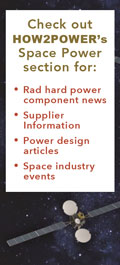 |
|
IN THIS ISSUE:
» Closing The Loop Of An Active-Clamp Forward Converter
» A Methodical Approach To Snubber Design
» Verifying Error Budget Analysis For A Buck Converter—On The Bench
» New Packages Offer Smaller Size, Greater Reliability For Rectifiers—With Some Tradeoffs
» Focus On Magnetics:
Designing Low-Power Flyback Inductors Using Tiny Toroids (Part 1): A Boost Converter Application
» Spotlight On Safety & Compliance:
Measuring Common-Mode And Differential-Mode EMI Currents
» New Power Products
» Industry Events:
- Strong Turnout For Workshop On Power Electronics Packaging
» Other Top Power News
From the Editor's Desk David G. Morrison
Editor, HOW2POWER TODAY

Power supply design presents diverse challenges at the circuit level. Some of these challenges are very specific to a particular power supply topology, control scheme or other function. Other challenges apply broadly to a wide range of power supply circuits. The articles in this issue reflect this dichotomy. First, we have Christophe Basso’s article on the active clamp forward converter in which he explains how to design the type three compensation circuit required by this popular topology. The control-to-output transfer function for the active clamp forward is complicated, and designing the compensator can be tricky. Basso offers detailed analysis of the transfer function and compensator, and describes a method of designing the compensator that uses both math tools and simulation so that the designer understands the influence of the relevant circuit elements. Other articles in this issue also look narrowly at issues such as error budget analysis in buck converters and flyback inductor design for boost converters. Meanwhile, some features address broader design challenges such as snubber design—Gregory Mirsky describes an analytical approach to designing RC snubbers, EMI filter design—how to measure common mode and differential mode EMI currents separately, and new package types for rectifiers. Although these subjects are broad in their applicability, the technical discussions are still quite detailed. This issue also offers a preview of the extensive plenary session at the next ECCE, a report on the recent International Workshop on Integrated Power Packaging, the latest new power components and more.
|
|
 |
 |

|
HOW2POWER EXCLUSIVE DESIGN ARTICLES 
|
Closing The Loop Of An Active-Clamp Forward Converter
by Christophe Basso, ON Semiconductor, Toulouse, France
This article describes in detail how to compensate an ACF. It introduces the ACF transfer function—something not seen previously in the literature—shows Bode plots for a design example based on the NCP1566 active-clamp PWM controller and discusses selection of the crossover frequency. The design of a type-3 compensator, as well as a strategy for applying this compensator to the ACF, is described and demonstrated using a Simplis simulation. All of this leads to the presentation of a complete circuit for the design example and its key features, circuit elements and additional design considerations are discussed. Finally, a common technique for making the Bode plot measurements of the loop’s gain and phase margins is reviewed and the benefits of using a low-cost oscilloscope and frequency response analyzer (Cleverscope) to make these measurements are highlighted.
Read the article…
|

The control-to-output transfer function
for the active-clamp forward shows a
resonating notch stressing the phase
where the double zeros appear. |

|

A properly designed simple RC
snubber can convert the resonant
(oscillating) process into an aperiodic
one, thus mitigating the EMC issues. |
A Methodical Approach To Snubber Design
by Gregory Mirsky, Continental Automotive Systems, Deer Park, Ill.
Even in a correctly designed switching power supply, stray capacitance and inductance in the traces and leads can cause oscillation in switching currents at turn-off due to the energy stored in these parasitic components. Since the oscillation may occur at many megahertz, satisfying requirements for the electromagnetic compatibility (EMC) of the switching power supply may be challenging. Properly designed snubbers may absorb the energy stored in the stray components and make the switching process smooth and oscillation-free. Unfortunately, many designers overlook the physical processes in switching circuits and just pick values for snubber components using trial and error, leading to poor results. This article explains the underlying process that leads to oscillation in switching power supplies and describes an analytical approach to designing an RC snubber that will effectively dampen the oscillation.
Read the article…
|

Verifying Error Budget Analysis For A Buck Converter—On The Bench
by Benjamin Lampe, Maxim Integrated, San Jose, Calif.
A previous article looked at hand calculations for buck converter error budgeting and saw how they stacked up against simulations from EE-Sim, Maxim Integrated's online SIMPLIS power supply design and simulation tool. This naturally leads to a deeper question: how closely do the hand calculations and models match bench measurements? Because at the end of the day, it's the physical silicon that matters, and all the calculations and simulations in the world won't help if they don't adequately model your real power supply. In this article, we go one step further in verifying the output voltage error budget analysis performed on the MAX17242 buck converter design by comparing simulation results with bench measurements on working hardware.
Read the article…
|

Comparing Bode plots of the power stage,
compensator and full loop obtained with
bench measurements versus simulation of
the buck converter IC model, makes it
possible to identify discrepancies and
tweak the model for better correlation. |

|

Newer packages for rectifier diodes
have a better die size-to-package
ratio. |
New Packages Offer Smaller Size, Greater Reliability For Rectifiers—With Some Tradeoffs
by Jos van Loo, Taiwan Semiconductor Europe, Zorneding, Germany and Kevin Parmenter, Tawian Semiconductor America, Chandler, Ariz.
Since the introduction of the SMA, SMB and SMC rectifiers in 1990 and 1991 (earlier for transient voltage suppressors), customers have complained about their height. In addition, the SMA/B/C packages were initially TVS packages and nobody ever claimed that their thermal design was very good. The rectifier industry just started using them because they were available at the time and customers wanted to replace MELFs. But the SMA/B/C packages reflected the technology available 30 years ago and there is room for improvement. As a result, a number of new packages have been introduced recently by Taiwan Semiconductor (TSC) and other vendors to address the shortcomings of these older packages. Sometimes downsizing to the newer packages will be easy and straightforward, but not always. This article will discuss how the smaller packages will influence designs and applications.
Read the article…
|

 |  |

FOCUS ON MAGNETICS 
Sponsored by Payton Planar Magnetics
A monthly column presenting information on power magnetics design, products, or related technology |

Designing Low-Power Flyback Inductors Using Tiny Toroids (Part 1): A Boost Converter Application
by Dennis Feucht, Innovatia Laboratories, Cayo, Belize
Power-converter design requiring 0.2 W to 2 W of power can most easily be solved with a linear supply. But in power-critical applications, if the input and output port voltages are significantly different, the result can be excessive or unnecessary power loss. The three configurations of PWM-switch converters can deliver the required power at high efficiency, though they involve the design of a small inductor. This article offers some insight into how core sizes relate to circuit requirements and presents a design example. Can toroid cores, such as iron-powder (Fe-pwd) cores that are as small as magnetic beads, be used for power conversion? The answer is affirmative. Though some agility is required in building the prototypes, it is less than required for working with TSSOP-size components on boards. Read the full story…
|

 |
 |

SPOTLIGHT ON SAFETY & COMPLIANCE 
Sponsored by Power Integrations
A monthly column discussing standards and regulatory requirements affecting power electronics |

Measuring Common-Mode And Differential-Mode EMI Currents
by Kevin Parmenter, Chair, and James Spangler, Co-chair, PSMA Safety and Compliance Committee
Line-conducted EMI current is composed of two elements: common mode (CM) current and differential mode (DM) current. Either one of these contributors to line-conducted EMI may be responsible for a unit failing EMC testing. And without knowing why a unit is failing, coming up with a solution can become a time-confusing exercise in trial and error. On the other hand, by measuring CM and DM EMI currents separately, engineers can identify why their products are exceeding the specified EMI limits and quickly tailor an EMI filter solution to pass EMC testing. Although the techniques for measuring CM and DM currents are well documented in the literature, many power supply engineers are still unfamiliar with them and therefore do not make these measurements. In this article, the authors review the literature regarding measurement of CM and DM EMI currents, offer an overview of the different measurement techniques and point to the references where readers can delve more into the details of making the measurements. Read the full article…
|

 |
 |

 — POWER PRODUCTS IN 3 IMAGES OR LESS — POWER PRODUCTS IN 3 IMAGES OR LESS 
|

|

Dialog Semiconductor’s SLG51000 CMIC. |
Programmable Multi-Channel LDO Packs High PSRR And Low Noise For Powering Smart Phone Cameras
 Diagram: Described as a configurable mixed-signal integrated circuit (CMIC) with high-PSRR, low-noise multi-output LDOs, the SLG51000 contains seven compact and customizable LDOs and is designed for powering image sensors in high-performance camera modules, advanced sensor systems, and other small multi-rail applications. Diagram: Described as a configurable mixed-signal integrated circuit (CMIC) with high-PSRR, low-noise multi-output LDOs, the SLG51000 contains seven compact and customizable LDOs and is designed for powering image sensors in high-performance camera modules, advanced sensor systems, and other small multi-rail applications.
 Measurements: The LDOs provide 73 dB of PSRR at 1 MHz and an output voltage noise of just 10 µV rms, enabling them to post regulate switcher-generated supply rails for image sensors and do so better than competing PMICs, according to the company. Measurements: The LDOs provide 73 dB of PSRR at 1 MHz and an output voltage noise of just 10 µV rms, enabling them to post regulate switcher-generated supply rails for image sensors and do so better than competing PMICs, according to the company.
See the full story… |


 |

|


Infineon Technologies’ zero-voltage-
switching switched-capacitor converter. |
Switched Capacitor Converter Reference Design Enables High Efficiency 48-V Power Distribution
 Photo: The zero-voltage-switching switched-capacitor (ZSC) converter generates an intermediate bus voltage with high efficiency, enabling a highly efficient two-stage (48 V to POL) architecture for powering CPUs, GPUs, SoCs, ASICs and memory. Photo: The zero-voltage-switching switched-capacitor (ZSC) converter generates an intermediate bus voltage with high efficiency, enabling a highly efficient two-stage (48 V to POL) architecture for powering CPUs, GPUs, SoCs, ASICs and memory.
See the full story…
|

Maxim Integrated Products’ MAX98390
smart amplifier.
|
Smart Class D Amplifier Delivers Louder, Richer Sound From Micro Speakers
 Diagram: The smart class D amplifier uses integrated IV sense and Maxim’s Dynamic Speaker Management (DSM) algorithm to drive speakers to their maximum specified limits, while protecting against over-excursion and overtemperature events. Competing solutions require a general-purpose DSP versus the fixed-function DSP in the MAX98390. Diagram: The smart class D amplifier uses integrated IV sense and Maxim’s Dynamic Speaker Management (DSM) algorithm to drive speakers to their maximum specified limits, while protecting against over-excursion and overtemperature events. Competing solutions require a general-purpose DSP versus the fixed-function DSP in the MAX98390.
 Graph: The DSM algorithm enables micro speakers to deliver 2.5X the loudness and deeper bass than with a conventional amplifier. By providing thermal and excursion protection, DSM makes it possible to ignore the micro speakers’ power rating while safely driving them to their true thermal and excursion limits. Graph: The DSM algorithm enables micro speakers to deliver 2.5X the loudness and deeper bass than with a conventional amplifier. By providing thermal and excursion protection, DSM makes it possible to ignore the micro speakers’ power rating while safely driving them to their true thermal and excursion limits.
See the full story…
|
 |
 |

Keysight Technologies’ E36200 series
power supplies.
|
Bench Friendly Power Supplies Deliver More Usable Power And Large Display
 Photo: The E36200 series of single- and dual-output power supplies provide the same measurement and advance capabilities as the company's E36300 triple-output power supply series, but deliver higher current and higher voltage. These autoranging dc power supplies offer ratings of 30 V, 20 A, 200 W or 60 V, 10 A, 200 W with single output; or ratings of 30 V, 20 A, 400 W or 60 V, 10 A, 400 W with dual output. Photo: The E36200 series of single- and dual-output power supplies provide the same measurement and advance capabilities as the company's E36300 triple-output power supply series, but deliver higher current and higher voltage. These autoranging dc power supplies offer ratings of 30 V, 20 A, 200 W or 60 V, 10 A, 200 W with single output; or ratings of 30 V, 20 A, 400 W or 60 V, 10 A, 400 W with dual output.
See the full story…
|

|













|

 |
 |
INDUSTRY EVENTS  |
|
Strong Turnout For Workshop On Power Electronics Packaging
by John Bultitude, PSMA Representative, and Andrew Lemmon, IWIPP 2019 Finance Chair
The 2019 International Workshop on Integrated Power Packaging (IWIPP) was held at the LAPLACE CNRS in Toulouse, France, April 24-26, 2019. Thierry Lebey, the director and general chair of the workshop, welcomed us to Toulouse on the first day. Attendance was up 30% compared to 2017 (94 registered attendees in 2019 vs. 72 in 2017). This increase in interest probably reflects the importance of improved power electronics packaging for more efficient power across many industries. Read the full story…
|

The International Workshop on Integrated
Power Packaging, which was held April 24-26
in Toulouse, France drew attendees from
across the globe.
|

|
OTHER TOP POWER NEWS
|
|
 PowerAmerica recently unveiled an updated wide bandgap technology roadmap. PowerAmerica recently unveiled an updated wide bandgap technology roadmap.
 Registration is now open for the premier event within the energy conversion field—the Energy Conversion Congress & Expo (ECCE), which will take place September 29 through October 3, 2019 in Baltimore, Maryland, USA. Registration is now open for the premier event within the energy conversion field—the Energy Conversion Congress & Expo (ECCE), which will take place September 29 through October 3, 2019 in Baltimore, Maryland, USA.


 APEC 2020 has announced its call for technical program paper submissions. APEC 2020 has announced its call for technical program paper submissions.
 On June 25, 2019, Maxim Integrated will host a webinar, “Simulate Switched-Mode Power Supplies Like a Pro” in which Brooks Leman will explain how to quickly and accurately evaluate your power circuits using the free EE-Sim OASIS Simulation Tool. On June 25, 2019, Maxim Integrated will host a webinar, “Simulate Switched-Mode Power Supplies Like a Pro” in which Brooks Leman will explain how to quickly and accurately evaluate your power circuits using the free EE-Sim OASIS Simulation Tool.


 Registration for the 2019 CPES short course, Modeling & Control Design of DC-DC Converters, is open. Registration for the 2019 CPES short course, Modeling & Control Design of DC-DC Converters, is open.
 Efficient Power Conversion (EPC) CEO and co-founder, Alex Lidow, has been inducted into the ISPSD Hall of Fame 2019. Efficient Power Conversion (EPC) CEO and co-founder, Alex Lidow, has been inducted into the ISPSD Hall of Fame 2019.
 Registration is open for SLED'19, the IEEE International Symposium on Sensorless Control for Electrical Drives, which will take place in Torino, Italy, on September 9-10, 2019. Registration is open for SLED'19, the IEEE International Symposium on Sensorless Control for Electrical Drives, which will take place in Torino, Italy, on September 9-10, 2019.
|

 |
|  |
|